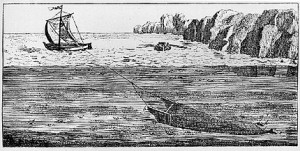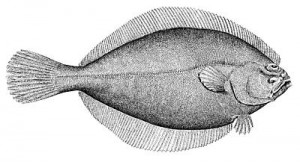“The commons petition the King, complaining that where in creeks and havens of the sea there used to be plenteous fishing, to the profit of the Kingdom, certain fishermen, for several years past have subtily contrived an instrument called the “wondyrechaun” made in the manner of an oyster dredge, but which is considerably longer, upon which instrument is attached a net so close meshed that no fish, be it ever so small which enters therein can escape, but must stay and be taken.
And that the great and long iron of the wondyrechaun runs so heavily and hardly over the ground when fishing that it destroys the flowers of the land below water there, and also the spat of oysters, mussels and other fish upon which the great fish are accustomed to be fed and nourished. By which instrument in many places, the fishermen take such quantity of small fish that they do not know what to do with them; and that they feed and fat their pigs with them, to the great damage of the commons of the realm and the destruction of the fisheries, and they pray for a remedy.”
Petition by the Commons to King Edward III, 1376 (from The Unnatural History of the Sea)
 This petition, penned in 1376, reveals a depth of understanding that we often don’t attribute to 14th century fishermen. Habitat destruction, overfishing, bycatch, even common pool resources are all clearly described here. In it, the Commons protests a new and efficient, though inaccurate fishing tool, the ‘wondyrechaun’, and begs King Edward III to ban it. This is the first historical record of the ‘wondyrechaun’, what today is called a beam trawl. Everything you need to know to understand why the world’s fisheries are in trouble is contained within the single fact that, in 1376, at it’s very inception, the people begged the king to ban it’s use, and 700 years later, the beam trawl survives.
This petition, penned in 1376, reveals a depth of understanding that we often don’t attribute to 14th century fishermen. Habitat destruction, overfishing, bycatch, even common pool resources are all clearly described here. In it, the Commons protests a new and efficient, though inaccurate fishing tool, the ‘wondyrechaun’, and begs King Edward III to ban it. This is the first historical record of the ‘wondyrechaun’, what today is called a beam trawl. Everything you need to know to understand why the world’s fisheries are in trouble is contained within the single fact that, in 1376, at it’s very inception, the people begged the king to ban it’s use, and 700 years later, the beam trawl survives.

Since its inception, we have known that the direct effects of trawling can be disastrous. Beam trawling can decrease the density of echinoderms, polycheates, and molluscs by up to 65%. Frequent trawling of a single area can prevent recovery entirely. The speed of the vessel, weight of the trawl, and frequency of disturbance all have a negative impact on benthic communities. Polycheates, which recover faster than other affected benthic organisms, may out-compete less effective re-populaters. In general, increased trawling results in community shifts from fragile, hard-bodied animals such as crustaceans and echinoderms, to soft-bodied animals, such as polychaetes.
These changes to the benthic community can have indirect affects on populations that prey on it. Even organisms that aren’t directly hunted by beam trawl will feel the ripples as ecosystem damage radiates out from it’s source. A recent study in the journal Marine Biology examined the indirect effects of trawling on the plaice, a commercially important fish, in the Celtic Sea.
 Plaice occur consistently in two benthic habitats – sand and gravel. In sand habitats they prey predominantly on polycheates, while in gravel habitats their prey consists of echinoderms and small crustaceans. The authors followed a gradient of trawling effort across both habitat types to determine if there were habitat-dependent indirect effects of trawling on plaice growth. They discovered that, in sand habitats, where the plaice prefer polychaetes, trawling had a small, positive effect on growth. In contrast, trawling over gravel, where the plaice eat crustaceans and echinoderms, had a strong negative effect on growth.
Plaice occur consistently in two benthic habitats – sand and gravel. In sand habitats they prey predominantly on polycheates, while in gravel habitats their prey consists of echinoderms and small crustaceans. The authors followed a gradient of trawling effort across both habitat types to determine if there were habitat-dependent indirect effects of trawling on plaice growth. They discovered that, in sand habitats, where the plaice prefer polychaetes, trawling had a small, positive effect on growth. In contrast, trawling over gravel, where the plaice eat crustaceans and echinoderms, had a strong negative effect on growth.
These indirect effects can be correlated to trawling activity, but there is a confounding factor. Over gravel seafloor, beam trawls are used 53% of the time, with the other 47% accounted for by otter trawls. Otter trawls are lighter and don’t do as much damage to the seafloor with each pass. On sandy seafloor, otter trawls account for 74% of all trawling, so the small positive effects of trawling on sandy seafloors may have less to do with changes in community structure and more to do with the minimal effects of a less destructive trawl design. The negative effects of beam trawling on gravel may represent order of magnitude decreases in prey abundance.
What all this means is exactly what the authors conclude – “The indirect effects of bottom trawling my prove just as serious as well-studied direct effects.”
Or, to paraphrase a 700 year old document:
“The great and long steel of the beam trawl runs so heavily over the seafloor that it destroys food sources – including juvenile fish and shellfish – that are prey for larger fish, yields massive amounts of bycatch, and compromises the common heritage and future of our marine resources.”
~Southern Fried Scientist
Shephard, S., Brophy, D., & Reid, D. (2010). Can bottom trawling indirectly diminish carrying capacity in a marine ecosystem? Marine Biology DOI: 10.1007/s00227-010-1502-9
Bergman, M., & Hup, M. (1992). Direct effects of beamtrawling on macrofauna in a sandy sediment in the southern North Sea ICES Journal of Marine Science, 49 (1), 5-11 DOI: 10.1093/icesjms/49.1.5
Jones, J. (1992). Environmental impact of trawling on the seabed: A review New Zealand Journal of Marine and Freshwater Research, 26 (1), 59-67 DOI: 10.1080/00288330.1992.9516500
Interesting post. Large-scale ocean fishing always scares me, because it’s so disruptive to ecosystems. I don’t know that we can expect to see it decrease in the near future, though, given how profitable it remains.
This is a great find, thanks for publicizing! But perhaps it’s just an example of the world’s second-oldest profession–fishermen complaining about the other guy’s tool.
Centuries later, commoners still find it difficult to persuade decision makers to move conservation legislation.
The Unnatural History of the Sea is a fine little book and well worth a read.
This little vignette once again shows the fallacy of thinking environmental consciousness began with a bunch of Western hippies in the 70s.
amen to that